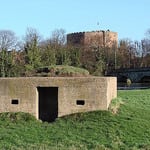Skift Take
The fate of the bunkers is debated in Albania where citizens are divided whether the eyesores should be refashioned as cultural monuments or discarded along with painful memories of the country’s past.
For some, they are an ugly, podlike reminder of Albania’s paranoid past that should be allowed to disappear unmourned. For others, the communist-era concrete bunkers that litter the small Adriatic state are a piece of cultural heritage that should not be lost.

Some bunkers have been turned into tattoo shops, restaurants, and art galleries. Photo by Elvis Payne.
Decades on from the heyday of the Albanian dictator Enver Hoxha, the domed bunkers are vanishing fast. Once upon a time there were as many as half a million of them, built to protect the isolated communist state from “imperialism and revisionism”. Now most have gone.
But some are determined to save the architectural oddities, with a range of creative solutions for reusing them. In Lezhë, 30 miles north of Tirana, a joint German-Albanian tourism venture is in the process of transforming a bunker into a no-frills hostel. At Tirana Ekspres, a vibrant arts centre near the capital’s dilapidated train station, a stage has been fashioned from three reconditioned bunker heads. Keq Marku Djetroshan, a tattoo artist, has gone one better, transforming one of the myriad bunkers built along the border with Montenegro into a tattoo parlour.
A new book featuring step-by-step guides for converting derelict bunkers into everything from hostels and toilets to cafes and gift shops was feted at the Venice Biennale, where it was recently launched. Elian Stefa, one of the authors of Concrete Mushrooms, estimates the cost of repurposing a triple bunker for campers at just €150 (£120). “The potential is huge, especially for tourism,” he said.
The dilemma – to destroy or refashion – splits Albanians. “There used to be bunkers in every town, every neighbourhood, but most have gone now,” said the veteran Albanian journalist Llazar Semini. “They [the Albanian government] have just closed an eye and an ear and let people destroy them slowly. Most people are happy for them to just disappear.”
Reputedly inspired by France’s interwar Maginot line and Vietcong defences against the US army, and erected with assistance from Chinese and North Korean engineers, Albania’s “bunkerisation” strategy accelerated in the mid-1970s. An increasingly paranoid Hoxha – who severed ties with Moscow in the wake of Nikita Khrushchev’s reforms – feared attack from the Soviet Union and Yugoslavia, as well as “the imperialist west”.
Though the bunkers were officially the purview of Albania’s ministry of defence, after the fall of Communist party rule in 1991 many farmers simply dug them up. More recently, impoverished Albanians have taken to blowing them up for their steel, typically worth around £100-150 for a large bunker for about 10 people.
“The technology for destroying the bunkers is spreading rapidly,” said Dorian Matlija, a lawyer who has defended a number of Albanians accused of blowing up bunkers. Explosives, typically ammonium nitrate, are often prepared in family homes. Bunker-busting is a dangerous business, but with average monthly incomes in Albania about £200, the lucrative explosions are unlikely to abate soon.
While many, particularly older Albanians, are unconcerned about the gradual obliteration of the concrete reminders of a brutal, highly militarised regime, others believe the igloo-shaped pillboxes and spacious underground shelters should remain.
“They are a testament to Albania’s past. They should be protected as cultural monuments. You cannot destroy them,” said Fatos Lubonja, a writer who spent 17 years in prison under the communists.
![]()
The Daily Newsletter
Our daily coverage of the global travel industry. Written by editors and analysts from across Skift’s brands.
Have a confidential tip for Skift? Get in touch
Tags: war tourism
